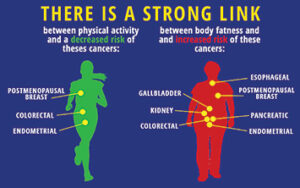Physical activity can lower the risk of developing 13 different kinds of cancer, including breast, colorectal and endometrial
 According to the American Cancer Society Guidelines on Nutrition and Physical Activity for Cancer Prevention, getting more physical activity is associated with a lower risk for several types of cancer, including breast, prostate, colon, endometrium and possibly pancreatic cancer.
According to the American Cancer Society Guidelines on Nutrition and Physical Activity for Cancer Prevention, getting more physical activity is associated with a lower risk for several types of cancer, including breast, prostate, colon, endometrium and possibly pancreatic cancer.
While you can’t control certain risk factors for cancer, like bad luck and genetics, there are things you can do to lower your odds. For example, it’s a fact that quitting smoking (or, better yet, never smoking) reduces your chances of developing many different types of cancer, from lung to liver.
And there are more steps you can take to keep cancer at bay. According to a 2018 report by the American Institute for Cancer Research and the World Cancer Research Fund, positive lifestyle changes — including eating right, maintaining a healthy body weight, and exercising — can cut the number of cancer diagnoses by 50 percent.
Exercise is one of the most powerful tools we have to modify cancer risk.
In a report published in the Journal of the American Medical Association, researchers at the National Cancer Institute and the American Cancer Society pooled data on close to 1.5 million people in the United States and Europe and concluded that exercise can reduce the odds of developing 13 different types of cancer.
This research confirmed the results of hundreds of earlier studies that found an association between physical activity, or a lack of it, and three common types of cancer: breast, colorectal and endometrial. Here’s more on what we know:
BREAST CANCER
Women who exercise lower their risk of developing breast cancer. An analysis of 31 studies published in the journal Breast Cancer Research and Treatment found a 12 percent reduction in breast cancer risk, on average, among physically active women — an effect that increased with age.
Exercise lowers levels of estrogen circulating in the blood. This is protective because higher levels of estrogen raise breast cancer risk.
Then there’s the impact of exercise on body weight. Postmenopausal breast cancer risk is higher for overweight and obese women, and that the risk rises as body mass index (BMI) increases. Obesity can lead to insulin resistance, causing higher than normal levels of insulin in the blood; research suggests this may help breast cancer cells develop and grow.
A major study which assessed women participating in the Nurses’ Health Study over several decades concluded that moderate physical activity (such as brisk walking a couple of times a week) reduces postmenopausal breast cancer risk, and that increasing physical activity after menopause may be beneficial.
Younger women may see their breast cancer risk drop, too. Researchers recruited 139 premenopausal women ages 18 to 50 who were at high risk for developing breast cancer. The low-dose group worked out on a treadmill 150 minutes a week; the high-dose group did twice as much; and a control group exercised one-half as much or less. Over the course of the study, the low- and high-dose groups saw reductions in estrogen-sensitive breast tissue of about 8 and 12 percent, respectively, while the control group showed a 20 percent increase.
COLORECTAL CANCER
The evidence linking regular physical activity with a decreased risk of developing colorectal cancer is compelling and consistent.
A review put the risk reduction for colon cancer at about 24 percent. There seems to be a dose-response relationship, which means there are more benefits associated with more exercise over a longer period of time, so as you age, if you continue to exercise, your risk continues to stay low.
One theory is that physical activity reduces “transit time” for waste moving through your large intestine, which lessens the amount of time the mucosa (the colon’s lining) is exposed to potential carcinogens, such as bile acids.
A study published in April 2017 found that recreational runners (the researchers looked at healthy, middle-aged men) had significantly reduced levels of bile acids in their blood, particularly those acids deemed carcinogenic.
ENDOMETRIAL CANCER
The evidence suggests that light- to moderate-intensity exercise lowers your risk of endometrial cancer, while spending a lot of time sitting increases risk, regardless of your weight or body mass index. A study found that heavier women who reported at least three hours a week of strenuous physical activity at the beginning of the study had a 24 percent lower risk of developing endometrial cancer over the next 12 years, compared with those who reported less than one-half hour per week of exercise.
The same reduced risk was not found for normal-weight women, indicating that the protective effect is greater for overweight and obese women. As with breast cancer, high levels of estrogen in the blood raise endometrial-cancer risk, and so does obesity; exercise can help alleviate both conditions.
While the evidence on exercise and cancer prevention is getting stronger all the time, there is more you can and should do to minimize cancer risk — from wearing sunscreen as protection against skin cancer to going to your doctor for recommended cancer screenings. Meanwhile, experts recommend some form of aerobic exercise – including walking, running or swimming – at least three times a week.


